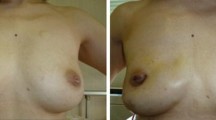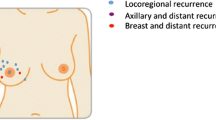Abstract
Background
Nipple-sparing mastectomy (NSM) is increasingly used in women with breast cancer who are not eligible for conservative surgery, but extensive outcome data are lacking and indications have not been established.
Objective
The aim of this study was to assess the oncological outcomes of NSM in a large series of patients with invasive or in situ breast cancer treated at a single center.
Methods
We analyzed 1989 consecutive women who had an NSM in 2003–2011, for invasive (1711 patients) or in situ cancer (278 patients) at the European Institute of Oncology, Italy, and followed-up to December 2016. Endpoints were local recurrences, recurrences in the nipple-areola complex (NAC), NAC necrosis, and overall survival (OS).
Results
After a median follow-up of 94 months (interquartile range 70–117), 91/1711 (5.3%) patients with invasive cancer had local recurrence (4.8% invasive disease, 0.5% in situ disease), and 11/278 (4.0%) patients with in situ disease had local recurrence (1.8% invasive disease, 2.2% in situ disease). Thirty-six (1.8%) patients had NAC recurrence, 9 with in situ disease (4 invasive and 5 in situ recurrences), and 27 with invasive disease (18 invasive and 9 in situ recurrences). NAC loss for necrosis occurred in 66 (3.3%) patients. There were 131 (6.6%) deaths, 109 (5.5%) as a result of breast cancer. OS at 5 years was 96.1% in women with invasive cancer and 99.2% in women with in situ disease.
Conclusions
The findings in this large series, with a median follow-up of nearly 8 years, indicate that NSM is oncologically safe for selected patients. The rate of NAC loss was acceptably low.


Similar content being viewed by others
References
Veronesi U, Stafyla V, Luini A, et al. Breast cancer: from “maximum tolerable” to “minimum effective” treatment. Front Oncol. 2012;2:125.
Rietjens M, Urban CA, Rey PC, et al. Long-term oncological results of breast conservative treatment with oncoplastic surgery. Breast. 2007;16:387–95.
Jabor MA, Shayani P, Collins DR Jr, et al. Nipple-areola reconstruction: satisfaction and clinical determinants. Plast Reconstr Surg. 2002;110:457–63.
Wei CH, Scott AM, Price AN, et al. Psychosocial and sexual well-being following nipple-sparing mastectomy and reconstruction. Breast J. 2016;22:10–7.
Didier F, Radice D, Gandini S, et al. Does nipple preservation in mastectomy improve satisfaction with cosmetic results, psychological adjustment, body image and sexuality? Breast Cancer Res Treat. 2009;118(3):623–33.
Zhong T, Antony A, Cordeiro P. Surgical outcomes and nipple projection using the modified skate flap for nipple-areolar reconstruction in a series of 422 implant reconstructions. Ann Plast Surg. 2009;62:591–95.
Simmons RM, Adamovich TL. Skin-sparing mastectomy. Surg Clin North Am. 2003;83:885–99.
Van Verschuer VM, Mureau MA, Gopie JP, et al. Patient satisfaction and nipple-areola sensitivity after bilateral prophylactic mastectomy and immediate implant breast reconstruction in a high breast cancer risk population: NSM versus SSM. Ann Plast Surg. 2016;77:145–52.
Djohan R, Gage E, Gatherwright J, et al. Patient satisfaction following nipple-sparing mastectomy and immediate breast reconstruction: an 8-year outcome study. Plast Reconstr Surg. 2010;125:818–29.
Sisco M, Yao KA. Nipple-sparing mastectomy: a contemporary perspective. J Surg Oncol. 2016;113:883–90.
Gahm J, Hansson P, Brandberg Y, et al. Breast sensibility after bilateral risk-reducing mastectomy and immediate breast reconstruction: a prospective study. J Plast Reconstr Aesthet Surg. 2013;66:1521–27.
Sarhadi NS, Shaw Dunn J, Lee FD, et al. An anatomical study of the nerve supply of the breast, including the nipple and areola. Br J Plast Surg. 1996;49:156–64.
Schlenz I, Kuzbari R, Gruber H, et al. The sensitivity of the nipple-areola complex: an anatomic study. Plast Reconstr Surg. 2000;105:905–9.
NCCN clinical practice guidelines in oncology: breast cancer, version 2.2016. https://www.nccn.org/professionals/physician_gls/default.aspx. Accessed 12 Sep 2018.
Fortunato L, Loreti A, Andrich R, et al. When mastectomy is needed: is the nipple-sparing procedure a new standard with very few contraindications? J Surg Oncol. 2013;108:207–12.
Özkurt E, Tükenmez M, Güven E, et al. Favorable outcome with close margins in patients undergoing nipple/skin sparing mastectomy with immediate breast reconstruction: 5-year follow-up. Balkan Med J. 2018;35:84–92.
Orecchia R, Veronesi U. Intraoperative electrons. Semin Radiat Oncol. 2005;15:76–83.
Veronesi U, Gatti G, Luini A, et al. Intraoperative radiation therapy for breast cancer: technical notes. Breast J. 2003;9:106–12.
Gorai K, Inoue K, Saegusa N, et al. Prediction of skin necrosis after mastectomy for breast cancer using indocyanine green angiography imaging. Plast Reconstr Surg Glob Open. 2017;5(4):e1321.
De Lorenzi F, Yamaguchi S, Petit JY, et al. Evaluation of skin perfusion after nipple-sparing mastectomy by indocyanine green dye. Preliminary results. J Exp Clin Cancer Res. 2005;24(3):347–54.
Kalbfleisch JD, Prentice RL. The statistical analysis of failure time data. New York: Wiley; 1980.
Gray RJ. A class of k-sample tests for comparing the cumulative incidence of a competing risk. Ann Stat. 1988;6:1141–54.
Altman DG, De Stavola BL, Love SB, et al. Review of survival analyses published in cancer journals. Br J Cancer. 1995;72:511–18.
Shimo A, Tsugawa K, Tsuchiya S, et al. Oncologic outcomes and technical considerations of nipple-sparing mastectomies in breast cancer: experience of 425 cases from a single institution. Breast Cancer. 2016;23:851–860.
Boneti C, Yuen J, Santiago C, et al. Oncologic safety of nipple skin-sparing or total skin-sparing mastectomies with immediate reconstruction. J Am Coll Surg. 2011;212:686–93.
Sakurai T, Zhang N, Suzuma T, et al. Long-term follow-up of nipple-sparing mastectomy without radiotherapy: a single center study at a Japanese institution. Med Oncol. 2013;30:481.
Laurberg T, Tramm T, Nielsen T, et al. Intrinsic subtypes and benefit from postmastectomy radiotherapy in node-positive premenopausal breast cancer patients who received adjuvant chemotherapy: results from two independent randomized trials. Acta Oncol. 2018;57:38–43.
Lai SF, Chen YH, Kuo WH, et al. Locoregional recurrence risk for postmastectomy breast cancer patients with T1-2 and one to three positive lymph nodes receiving modern systemic treatment without radiotherapy. Ann Surg Oncol. 2016;23:3860–69.
Scheer AS, Zih FS, Maki E, et al. Post-mastectomy radiation: should subtype factor into the decision? Ann Surg Oncol. 2016;23:2462–70.
Dominici LS, Mittendorf EA, Wang X, et al. Implications of constructed biologic subtype and its relationship to locoregional recurrence following mastectomy. Breast Cancer Res. 2012;14:R82.
Headon HL, Kasem A, Mokbel K. The oncological safety of nipple-sparing mastectomy: a systematic review of the literature with a pooled analysis of 12,358 procedures. Arch Plast Surg. 2016;43:328–38.
Lohsiriwat V, Rotmensz N, Botteri E, et al. Do clinicopathological features of the cancer patient relate with nipple areolar complex necrosis in nipple-sparing mastectomy? Ann Surg Oncol. 2013;20:990–6.
Garwood ER, Moore D, Ewing C, et al. Total skin-sparing mastectomy: complications and local recurrence rates in 2 cohorts of patients. Ann Surg. 2009;249:26–32.
Setälä L, Papp A, Joukainen S, et al. Obesity and complications in breast reduction surgery: are restrictions justified? J Plast Reconstr Aesthet Surg. 2009;62:195–99.
O’Grady KF, Thoma A, Dal Cin A. A comparison of complication rates in large and small inferior pedicle reduction mammaplasty. Plast Reconstr Surg. 2005;115:736–42.
De La Cruz L, Moody AM, Tappy EE, et al. Overall survival, disease-free survival, local recurrence, and nipple-areolar recurrence in the setting of nipple-sparing mastectomy: a meta-analysis and systematic review. Ann Surg Oncol. 2015;22:3241–49.
Medina-Franco H, Vasconez LO, Fix RJ, et al. Factors associated with local recurrence after skin-sparing mastectomy and immediate breast reconstruction for invasive breast cancer. Ann Surg. 2002;235:814–19.
Crowe JP Jr, Gordon NH, Antunez AR, et al. Local-regional breast cancer recurrence following mastectomy. Arch Surg. 1991;126:429–32.
Tokin C, Weiss A, Wang-Rodriguez J, et al. Oncologic safety of skin-sparing and nipple-sparing mastectomy: a discussion and review of the literature. Int J Surg Oncol. 2012;2012:921821.
Acknowledgment
The authors thank Maria Grazia Villardita for help with manuscript preparation, and Don Ward for help with the English.
Funding
No financial support was received for this study.
Author information
Authors and Affiliations
Corresponding author
Ethics declarations
Conflicts of interest
Viviana Galimberti, Consuelo Morigi, Vincenzo Bagnardi, Giovanni Corso, Elisa Vicini, Sabrina Kahler Ribeiro Fontana, Paola Naninato, Silvia Ratini, Francesca Magnoni, Antonio Toesca, Andriana Kouloura, Mario Rietjens, Francesca De Lorenzi, Andrea Vingiani, and Paolo Veronesi have no conflicts of interest to declare.
Rights and permissions
About this article
Cite this article
Galimberti, V., Morigi, C., Bagnardi, V. et al. Oncological Outcomes of Nipple-Sparing Mastectomy: A Single-Center Experience of 1989 Patients. Ann Surg Oncol 25, 3849–3857 (2018). https://doi.org/10.1245/s10434-018-6759-0
Received:
Published:
Issue Date:
DOI: https://doi.org/10.1245/s10434-018-6759-0




